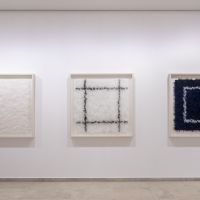TURNO DE RĂPLICA. CONSTRUCCIĂN/COMPOSICIĂN
Una mirada a la ColecciĂłn Arte ContemporĂĄneo

[English version below]
Los museos de arte, custodios de colecciones formadas por artefactos producidos en los diferentes momentos de nuestra historia, tienen como objetivo primordial el cuidado y la preservaciĂłn de dichas obras, la creaciĂłn de contextos que fomenten su visibilizaciĂłn para que podamos conocer el tiempo y los condicionantes bajo las que fueron realizadas y, como se viene dando y viendo con nitidez en las Ășltimas dĂ©cadas, el cuestionamiento del modo en que esas obras de arte han sido leĂdas por posiciones precedentes a las nuestras, que no es sino decir que el tiempo en que vivimos es aquĂ©l en el que se ponen en duda las rigurosas y rotundas afirmaciones que un dĂa tejieron las historias del arte canĂłnicas.
âTurno de rĂ©plicaâ es el tĂtulo de una exposiciĂłn de la que forma parte un nĂșmero importante de obras de la ColecciĂłn Arte ContemporĂĄneo, fundamentalmente aquellas que se inscriben en tres momentos histĂłricos, los años veinte y treinta, los años cincuenta y los años sesenta y setenta o, lo que es lo mismo, la vanguardia, la abstracciĂłn y el arte minimal y conceptual, si bien hay obras, las menos, que exceden estos lĂmites temporales. El conjunto de obras de la ColecciĂłn que se inscriben en estos tres movimientos o âmomentosâ brillan con especial fulgor y a ellas quiere dirigirse ahora un conjunto de obras de artistas españoles, todos ellos activos hoy, que proponen una suerte de ârĂ©plicaâ, cuestionando o, al menos, respondiendo a las pautas que en su dĂa abordaron sus mayores.
âTurno de rĂ©plicaâ, con sus resonancias parlamentarias, propone un diĂĄlogo que nace de una interpelaciĂłn generacional a los ecos de la vanguardia que resuenan hoy en las obras de artistas contemporĂĄneos. âTurno de rĂ©plicaâ quiere ser un tĂtulo genĂ©rico que alumbre diferentes lecturas de la ColecciĂłn Arte ContemporĂĄneo en montajes sucesivos. La que nos ocupa hoy lleva por tĂtulo âConstrucciĂłn/ComposiciĂłnâ y tiene que ver con las drĂĄsticas transformaciones que asuntos germinales en toda creaciĂłn como la reflexiĂłn en torno al plano, la forma, el volumen o el espacio han sufrido y sufren en nuestro tiempo, a la luz del advenimiento de la tecnologĂa digital, de las âconsideraciones de la demasĂaâ de las imĂĄgenes, de las nuevas relaciones entre continente y contenido en el ĂĄmbito de lo expositivo y de la nueva performatividad de las obras de arte. Si anteriores lecturas de la colecciĂłn trenzaban una relaciĂłn de âparentescoâ entre los artistas, lo que aquĂ se propone, como viene siendo habitual en el programa Ășltimo del museo, es una relaciĂłn de consensos y disensos, de analogĂas y fracturas que puedan ofrecer nuevas perspectivas en torno al arte en nuestro paĂs de ayer y de hoy.
Artistas participantes: Elena Alonso, Manuel Ăngeles Ortiz, Elena Asins, Rafael Barradas, Francisco Bores, Pancho CossĂo, MarĂa Luisa FernĂĄndez, Fuentesal Arenillas, Julio GonzĂĄlez, Irene Infantes, Manolo Laguillo, NicolĂĄs de Lekuona, Maruja Mallo, Manuel Millares, JosĂ© Moreno Villa, Lucio Muñoz, Alfonso de Olivares, Jorge Oteiza, Pablo Palazuelo, BenjamĂn Palencia, Damaris Pan, Alberto Peral, Guillermo Pfaff, Elena del Rivero, Joan Sandalinas, Adolfo Schlosser, Eusebio Sempere, Ignacio Uriarte, Oriol Vilanova.
QUESTION TIME
CONSTRUCTION/COMPOSITION
The main goal of art museums, the custodians of collections made up of artefacts produced at different times in our history, is the care and preservation of these pieces, the creation of contexts that promote their visibility so that we can learn about the time and conditions under which they were made, and, as has been happening and becoming clear in recent decades, the questioning of the way in which these works of art have been read by positions preceding our own. This means that the time in which we live is one in which the rigorous and categorical affirmations that were once woven into the canonical histories of art are now being questioned.
âQUESTION TIMEâ is the title of an exhibition that includes a significant number of pieces from the Contemporary Art Collection, mainly those that fall within three different historical periods, the 1920s and 1930s, the 1950s, and the 1960s and 1970s, or, in other words, the avant-garde, abstraction and minimal and conceptual art, although there are pieces â but not so many â that fall outside these time limits. The pieces in the Collection that fall within these three movements or âmomentsâ shine with a unique light, and it is to them that a group of pieces by Spanish artists, all of them still active today, propose a kind of âanswering backâ, questioning, or at least a response to the guidelines that their elders addressed in their time.
With its parliamentary resonances, âQuestion Timeâ proposes a dialogue born of a generational call to the echoes of the avant-garde that resonate today in the work of contemporary artists. âQuestion Timeâ is intended to be a generic title that will illuminate different readings of the Contemporary Art Collection in successive stagings. The one we are dealing with today is entitled âConstruction/Compositionâ and has to do with the drastic transformations that germinal issues in all creation, such as reflection on the plane, form, volume and space, have suffered and are suffering in our time, in the light of the advent of digital technology, of the âconsiderations of the excessâ of images, of the new relations between container and content in the field of the exhibition and of the new performativity of works of art. If previous readings of the collection have involved a relationship of âkinshipâ among artists, what is proposed here, as has become regular practice in the museumâs latest programme, is a relationship of consensus and dissent, of analogies and fractures that can provide new perspectives on art in our country yesterday and today.













